Services on Demand
Journal
Article
Indicators
-
 Cited by SciELO
Cited by SciELO
Related links
-
 Similars in
SciELO
Similars in
SciELO  uBio
uBio
Share
Phyton (Buenos Aires)
On-line version ISSN 1851-5657
Phyton (B. Aires) vol.78 no.1 Vicente López Jan./June 2009
ARTÍCULOS ORIGINALES
Herbal medicinal teas from South Africa
Tés de hierbas medicinales de Sudáfrica
1 Department of Botany, University of Venda, Thohoyandou, Limpopo 0950, South Africa.
2 McGregor 6708, South Africa.
Address Correspondence to: Prof. R.B. Bhat, Department of Botany, University of Venda, Private Bag X5050 Thohoyandou -0950, South Africa Tel. +27-15-962-8144, e-mail: bhatrb@yahoo.com
Recibido-Received 04.08.2009.
Aceptado-Accepted 22.08.2009.
Abstract. An investigation of herbal medicinal teas from Western Cape, South Africa was conducted to assess the varieties of herbal teas used to treat various ailments. Each packet of medicinal tea is a blend of carefully selected four or more herbs which are commonly grown in the organic garden in an ancient valley near the southernmost tip of South Africa and some indigenous herbs picked up in the nearby mountains. The teas are specific for the diseased organ/s and also include the herbs to support and strengthen the systems serving the ailing organ/s. The study shows that there are about twenty-one different types of herbal teas, and the packets of 50 g each are sold in South African markets under the trade names of Arthritea, Asthmitea, Constipatea, Detoxtea, Diabetea, Dietea, Energetea, Flootea, Hangovertea, Heartburntea, Hi Lo B P Tea, Indigestea, Kidneytea, Liveritea, Relaxitea, Sleepitea, Slimtea, Tranquilitea, Tummytea, Ulcertea, and Voomatea. They include 28 herbal species belonging to 12 families. The efficacy of herbal teas and use of traditional remedies are held with high esteem in South Africa.
Key words: Common ailments; Traditional phytotherapy; South Africa.
Resumen. Se condujo una investigación de té provisto a partir de hierbas medicinales de Western Cape, Sudáfrica, para evaluar las variedades de té en hierbas utilizadas para tratar varias dolencias. Cada paquete de té medicinal es una mezcla de cuatro o más hierbas cuidadosamente seleccionadas que crecen comúnmente en el jardín orgánico de un valle antiguo cerca de la punta más austral de Sudáfrica, y de algunas hierbas nativas recogidas en las montañas cercanas. Cada té es específico para el/los órgano/s enfermo/s y también incluye las hierbas para fortalecer al/los órgano/s enfermo/s. El estudio muestra que hay cerca de 21 tipos diferentes de té de hierbas, y los paquetes de 50 g cada uno se venden en los mercados de Sudáfrica bajo los siguientes nombres comerciales: Arthritea, Asthmitea, Constipatea, Detoxtea, Diabetea, Dietea, Energetea, Flootea, Hangovertea, Heartburntea, Hi Lo B P Tea, Indigestea, Kidneytea, Liveritea, Relaxitea, Sleepitea, Slimtea, Tranquilitea, Tummytea, Ulcertea y Voomatea. Éstos incluyen 28 especies de hierbas pertenecientes a 12 familias. La eficacia de té de hierbas y el uso de remedios tradicionales son muy valorados en Sudáfrica.
Palabras clave: Dolencias comunes; Fitoterapia tradicional; Sudáfrica.
INTRODUCTION
The use of plants with medical properties is especially meaningful among the indigenous population groups of South Africa. This is because of the great variety of vegetal species that belong to their ecosystems, a fact that increases the number of available resources. The second half of the twentieth century has seen a gradual loss in the value of plants in therapeutics and, as a consequence, of the interest in the use of plants with medical purposes (Bonet et al., 1992). It is an unfortunate incident that this knowledge on phytomedicine is rapidly being lost with the modernisation of society, especially by the development of road communication, migration of people from villages to cities, and the influx of modern medicine.
A few vigorous surveys on traditional medicine have been conducted in South Africa. In previous studies, data collected from different districts were presented merely as a list of plants and their uses (Lamla, 1981; Hutchings, 1989; Simon & Lamla, 1991; Bhat & Jacobs, 1995) without any specific emphasis on what ailments they cure. Bolofo & Johnson (1988) took the first initiative when they made an extensive study on ‘Isicakathi', a medicinal plant administered as a purge to newly-born infants. In their study, they identified eleven plant species in six districts of Transkei (South Africa) which are known as `Isicakathi'. Later, another document containing valuable information on children-oriented plant-derived remedies was recorded by Dlisani & Bhat (1999). Their work focused on 20 plant species medicinally used for maternity and child health. The purpose of this study was, therefore, to collect reliable information about the remaining plant species which can be used in traditional medicine in this region of South Africa, before they are completely lost. Much emphasis in this study has been placed on those plant-derived remedies that are used as herbal medicinal teas for the treatment of various ailments.
MATERIALS AND METHODS
Botanical fieldwork was focused on the Western Cape, South Africa. The samples of herbal teas were collected from the farm in the Western Cape where the herbs are cultivated.
Exhaustive field notes were recorded with regard to the usefulness of the herbs following some of the methods of Croom (1983), and Bhat et al. (1990). Approximately two hundred people were interviewed from different parts of the Western Cape. Each group consisted of twenty to thirty literate adults of various age groups. Both males and females took part in the interview. The random interview was focused equally in urban and suburban areas. Commercial names of the packets of herbal teas are provided, which can be easily purchased in the Western Cape markets.
RESULTS
Twenty eight plant species had been reported to date which are used for the preparation of herbal medicinal teas. In our enumeration, medicinal teas are alphabetically arranged and data are presented in the following sequence: botanical name, common names, and information on uses. Each herbal tea packet is produced with a combination of many herbs. As such, many of the herbs are repeated in the different formulae having different concentrations in the mixtures.

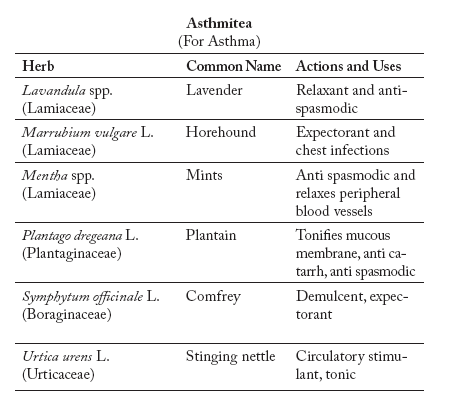



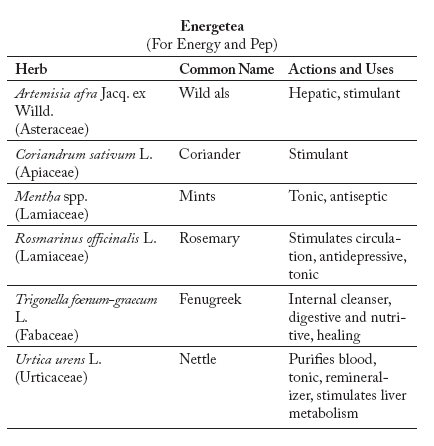


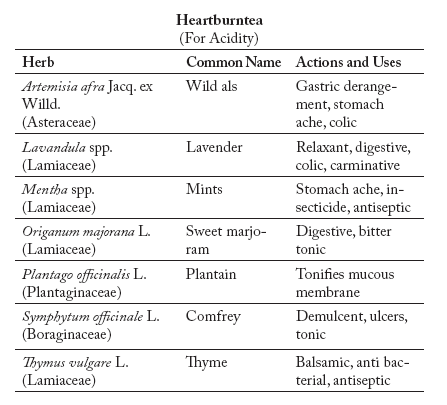



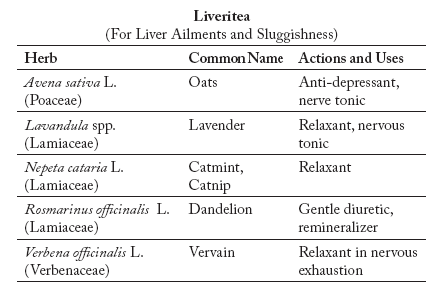


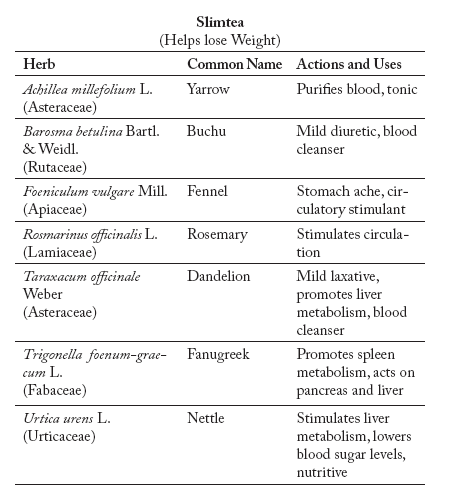
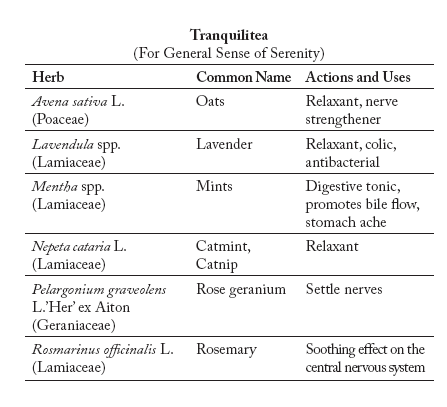



DISCUSSION AND CONCLUSIONS
Ethnobotanical work is intended to bring light to the traditional knowledge about plant use and its cultural significance. This could contribute to (1) better ways of renewable natural resource utilization, (2) propose medicinal plant management according to the anthropological needs and characters of the human groups over whom they are planned to intercede (Zamora-Martinez & De Pascual Pola, 1992). The plant kingdom represents a source of food and medicine. Therefore, with the tendency in modern medicine to assimilate and re-assimilate natural remedies in common practice, under various forms, the potential of regional flora becomes very important (De Feo et al., 1992). In the Western Cape of South Africa there are approximately twenty-one herbal teas prepared from twenty eight plant species belonging to twelve families. Approximately 35% of the species belong to the family Lamiaceae. Packets of 50 g each are sold in South African markets, mainly in the Western Cape. No adverse statements have been reported for the herbal teas. Further scientific and experimental research is required to have a better understanding of these herbal teas.
ACKNOWLEDGEMENTS
The authors are grateful to the people of Western Cape and other parts of South Africa for sharing their personal experience and knowledge on this project.
REFERENCES
1. Bhat, R.B., E.O. Etejere & V.T. Oladipo (1990). Ethnobotanical studies from central Nigeria. Economic Botany 44: 382-390. [ Links ]
2. Bhat, R.B. & T.V. Jacobs (1995). Traditional herbal medicine in Transkei. Journal of Ethnopharmacology 48: 7-12. [ Links ]
3. Bolofo, R.N & C.T. Johnson (1988). The identification of "Isicakathi" and its medicinal use in Transkei. Bothalia 18: 125-130. [ Links ]
4. Bonet, M.A., C. Blanche & J.V. Xiran (1992). Ethnobotanical study in the River Tenes valley (Catalonia, Iberian Peninsula). Journal of Ethnopharmacology 37: 205-212. [ Links ]
5. Croom, E. M. (1983). Documenting and evaluating herbal remedies. Economic Botany 37: 13-27. [ Links ]
6. De Feo, V., R. Aquino, A. Menghini, E. Ramundo & F. Senatore (1992). Traditional phytotherapy in the Peninsula Sorrentina, Compania, Southern Italy. Journal of Ethnopharmacology 36: 113-125. [ Links ]
7. Dlisani, P.B. & R.B. Bhat (1999). Traditional Health Practises in Transkei with special emphasis on Maternal and Child Health. Pharmaceutical Biology 37: 32-36. [ Links ]
8. Hutchings, A. (1989). Observations on plant usage in Xhosa and Zulu medicine. Bothalia 19: 225-235. [ Links ]
9. Lamla, M. (1981). Traditional Healers and Their Medicine. Lumko occasional Paper 2. Cacadu, Transkei, 59 pp. [ Links ]
10. Simon, C. & M. Lamla (1991). Merging pharmacopoeia: understanding the historical origins of incorporative pharmacopoeial process among Xhosa healers in southern Africa. Journal of Ethnopharmacology 33: 237-242. [ Links ]
11. Zamora-Martinez, M.C. & C.N. De Pascual Pola (1992). Medicinal plants used in some rural populations of Oaxaca, Puebla, and Veracruz, Mexico. Journal of Ethnopharmacology 35: 229-257. [ Links ]














